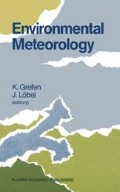Abstract
During July and August 1987, the project “VISAS”, short for “Vienna Summer Aerosol Study”, was carried out. Its purpose was to determine the chemical and meteorological conditions in the summertime boundary layer over the city of Vienna esp. during anticyclonic conditions. For the meteorological measurements, a SODAR and a tethersonde supplemented the routine network. Three examples of the SODAR’s performance in detecting mixing heights are shown; these are compared with mixing heights derived from the tethersonde and from radiosonde temperature profiles. Often, there is a good agreement between the three systems; differences and failures can be explained meteorologically.
Access this chapter
Tax calculation will be finalised at checkout
Purchases are for personal use only
Preview
Unable to display preview. Download preview PDF.
References
Ball, F.K. (1960): Control of inversion height by surface heating. Quart. J. R. Met. Soc. 86, 483–494.
Benkley, C.W. and L.L. Schulman (1979): Estimating hourly mixing depths from historical meteorological data. J. Appl. Meteor. 18, 772–780.
Brown, E.H. and F.F. Hall Jr. (1978): Advances in atmospheric acoustics. Rev. Geophys. Space Phys. 16, No. 1, 47–110.
Gamo, M. and O. Yokoyama (1979): Growth of the mixing depth and the diurnal variation of vertical profiles of temperature and turbulence characteristics in the mixing layer. J. Met. Soc. Japan, 57, Nr. 2, 159–171.
Olsson, L.E., M.P. McCormick, W.P. Elliott, S.H. Melfi (1974): An observational study of the mixing layer in western Oregon. Atm. Environment 8, 241–252.
Puxbaum, H., et al.: The Vienna Summer aerosol study of 1987 (in preparation).
Russell, P.B. and E.E. Uthe (1978): Regional patterns of mixing depth and stability. Sodar network measurements for input to air quality models. Bull. Am. Met. Soc. 59, No. 10, 1275–1287.
Author information
Authors and Affiliations
Editor information
Editors and Affiliations
Rights and permissions
Copyright information
© 1988 Kluwer Academic Publishers
About this chapter
Cite this chapter
Piringer, M. (1988). The Determination of Mixing Heights by Sodar in an Urban Environment. In: Grefen, K., Löbel, J. (eds) Environmental Meteorology. Springer, Dordrecht. https://doi.org/10.1007/978-94-009-2939-5_31
Download citation
DOI: https://doi.org/10.1007/978-94-009-2939-5_31
Publisher Name: Springer, Dordrecht
Print ISBN: 978-94-010-7823-8
Online ISBN: 978-94-009-2939-5
eBook Packages: Springer Book Archive

